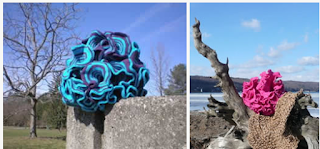In this weeks lecture, I have gained a lot of
insight about mathematics and the ways in which they influence art and science.
Professor Vesna states how “the connection of art and science is through the
mathematics” and that they go side by side. In The Fourth
Dimension and Non-Euclidean Geometry in Modern Art: Conclusion, Henderson mentions how the four
dimensions could be on the verge of a new phase of influence especially with
mathematics (209). Mathematics has a major influence from when the Greeks like
Brunelleschi started to use perspective and mathematical laws on their art work
(Mathematics and Art- Perspective). The
role of mathematics is very important in the way artist demonstrate their
artwork and create a whole new perspective on art.
 |
| http://www.humanitiesweb.org/spa/gcp/ID/1215 Filippo Brunelleschi San Lorenzo
Maurtis Cornelis Escher, who had no special
training or knowledge in mathematics, created graphic arts that mathematicians
admired. Ultimately, his work became something more than just graphic art; it
led to similar duplicates being created from his work in mathematical themes,
sculptures and on public buildings (The Mathematical Art of M.C. Escher).
In the "Circle Limit" series
of woodcut prints, Escher invented his own construction plan for hyperbolic
geometry.
When I first think of art, mathematics is not something that comes to mind. However discovering more about art, mathematics actually plays a huge role in how the art is created or viewed. I learned that artists/scientists use
mathematics in all different forms of their artwork to express their perspective on it. Juxtaposition is defined as being close together or side by side. Explaining it with mathematics, art and science, theses all are all in relation to each other and all three can be compared/linked together. Overall, mathematics is very important in the way people view art and is essential for art to have a creative affect on people.
|
Two of Daina's enormous hyperbolic planes
in blue and pink, pictured in the wilds of Ithaca NY.
|
Work Cited
1.
Henderson,
Linda Dalrymple. "The Fourth Dimension and Non-Euclidean Geometry in
Modern
Art: Conclusion." Leonardo 17.3 (1984):
205-10. JSTOR. Web. 11 Apr. 2016.
2.
Smith, B. Sidney.
"The Mathematical Art of M.C. Escher."Platonic Realms Minitexts. Platonic
Realms, 13 Mar 2014. Web. 13 Mar 2014. http://platonicrealms.com/3. Taimina, Daina. "DISCOVERER OF HYPERBOLIC CROCHET." Daina Taimina. Web. Apr. 2009.
4. "Mathematics and Art - Perspective." Mathematics and Art. J J O'Connor and E F Robertson, Web. Jan. 2003.
5. Vesna, Victoria. “Math + Art.” Lecture 2
Images


Hi Karly. It's nice to see you mentioned Escher, too. I definitely agree with you on that he "created graphic arts that mathematicians admired". In my blog, I said he was many computer scientists' favorite artist. I am a fan of him, too.
ReplyDelete